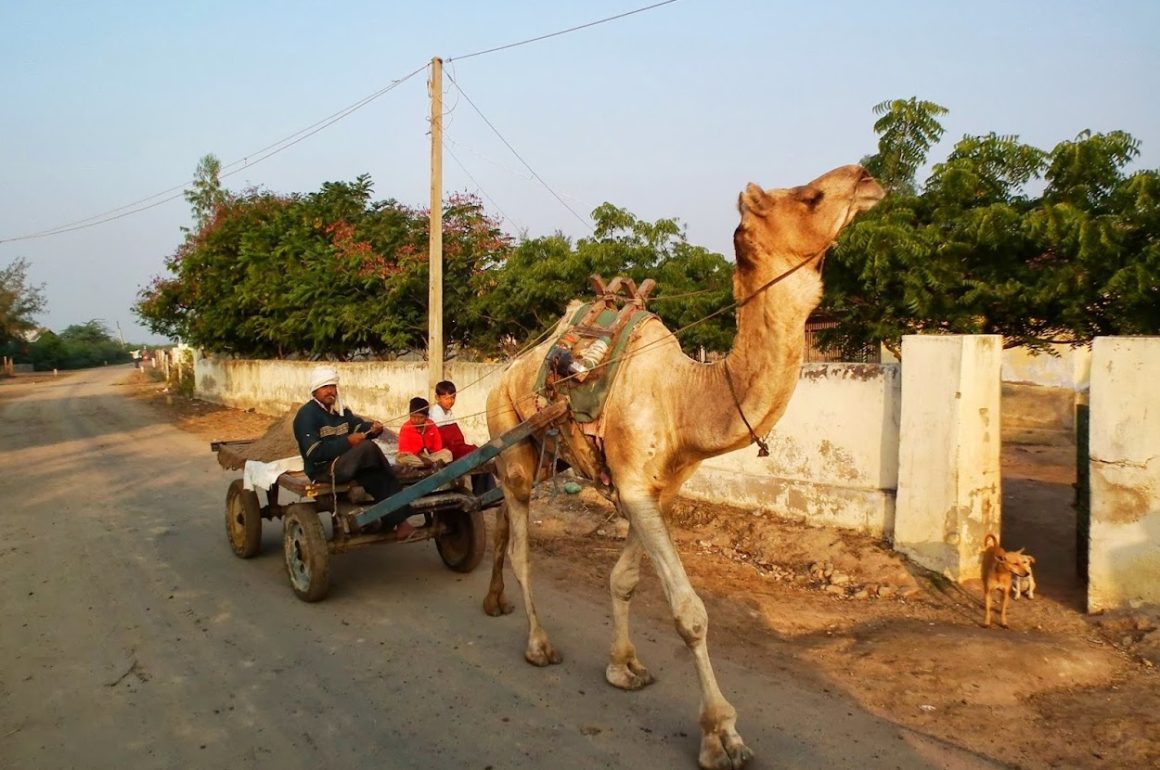
Gujarat, December 2010
Target for today: critically endangered Sociable Lapwing (Vanellus gregarius). The official definition of CR status says the species could be gone within ten years, or could lose 80 per cent of its population within three generations – whichever comes first. CR being the highest category in the Red List, if I want to see some of those birds, I better hurry!
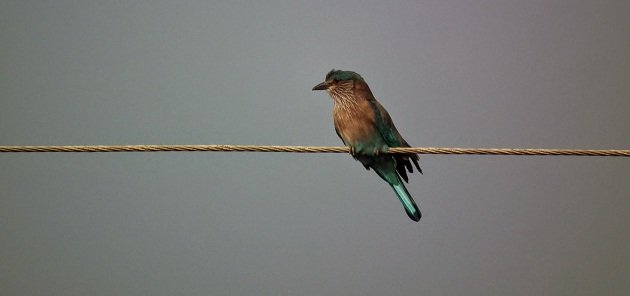 In an open Maruti Gypsy, we are heading north from Dasada in the Little Rann of Kutch, Gujarat, along a rather decent tarmac road, between the wheat fields and passing camel carts. Ubiquitous Indian Roller (above) on the wire by the road, a pair of Brahminy Starlings further away, Grey Francolins disappearing in the grass, Wooly-necked Storks in the fields… even two huge Sarus Cranes in the distance.
In an open Maruti Gypsy, we are heading north from Dasada in the Little Rann of Kutch, Gujarat, along a rather decent tarmac road, between the wheat fields and passing camel carts. Ubiquitous Indian Roller (above) on the wire by the road, a pair of Brahminy Starlings further away, Grey Francolins disappearing in the grass, Wooly-necked Storks in the fields… even two huge Sarus Cranes in the distance.
Sam, our driver/guide, is stopping the Gipsy on the small bridge above the canal and the six of us are scanning the fields with binoculars. Sociable Lapwings here overwinter in fields with young wheat. But something is clearly wrong – only Red-wattled Lapwings are showing. There is no sign of Sociables.
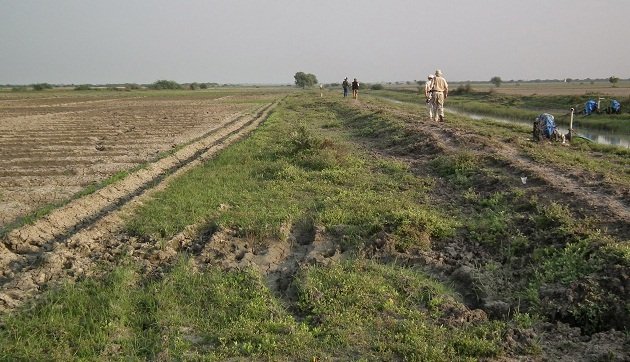 The road follows the dyke and Sam drives steeply down towards the canal, continuing along the water’s edge. Frantic search – Peter is even running by the canal, scanning the fields occasionally. Red-wattled Lapwings are still numerous, but Sociables are still missing. Sam claims that they are always there, 26 of them only a week ago. Locals being vegetarians, why are there no birds?
The road follows the dyke and Sam drives steeply down towards the canal, continuing along the water’s edge. Frantic search – Peter is even running by the canal, scanning the fields occasionally. Red-wattled Lapwings are still numerous, but Sociables are still missing. Sam claims that they are always there, 26 of them only a week ago. Locals being vegetarians, why are there no birds?
Sociable Lapwings breed in several areas along the Kazakhstani – Russian border and overwinter in Iraq, Sudan and northwest India. Reasons for their decline include steppes being turned into arable fields – the reason they disappeared from Ukraine and European Russia, on migration they are hunted with guns and falcons, and on their wintering grounds natural habitat is dwindling in the absence of once large herds of wild ungulates (one should try to see these animals as gardeners of a well-kept landscape).
Actually, despite the fact that central Asian steppes cover huge areas, Sociable Lapwings breed only around nomadic cattle herders’ settlements, which signifies that this species has evolved alongside wild ungulates, such as Blackbuck and Saiga antelopes, which kept the grass short. With overhunting and the population crash in antelopes and Indian Wild Ass, these lapwings have gone from large areas and are nowadays found only with domestic herds. That can be traced back in time to 1875, when Alfred Brehm wrote that he had found Sociable Lapwings only alongside the domestic cattle. These birds even lay their eggs on piles of cow or horse dung, most likely to elevate them from the cold ground and possibly provide some heating through the process of rotting plant material.
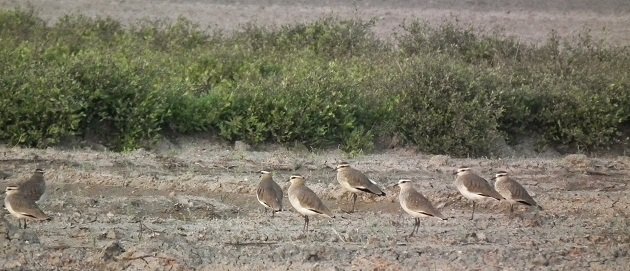 Peter is running back from his recce: some 600 meters away, he has noticed about 15 Sociable Lapwings in flight! Back to Gipsy and toward a distant group of farmers working their fields. Five excited pairs of eyes are scanning the ground… By dirt tracks in between fields, we come ever closer, bit by bit. At first, we observe from afar.
Peter is running back from his recce: some 600 meters away, he has noticed about 15 Sociable Lapwings in flight! Back to Gipsy and toward a distant group of farmers working their fields. Five excited pairs of eyes are scanning the ground… By dirt tracks in between fields, we come ever closer, bit by bit. At first, we observe from afar.
I am trying to count them, but they keep walking and searching for food, so a few birds remain hidden from me at any given time. One, two, three… 26! Let’s check that… one, two… 27! Did I counted some pile of dirt as a bird? Again, two, three… 26. And again, just in case… three, four… 28! Few minutes later, Peter confirms my last count.
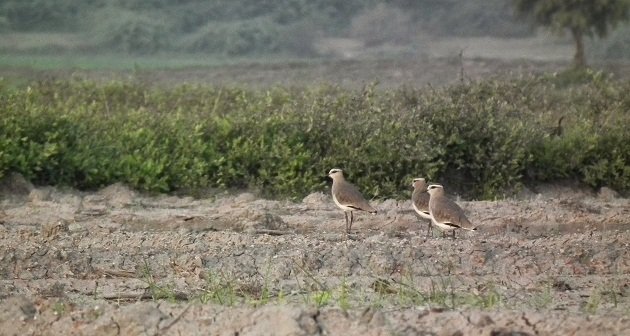 On our way back to the lodge, passing the village outskirts in the cold of the winter sunset, the last sight of the day: a large dry tree… with no less but six Indian Peafowl roosting in it.
On our way back to the lodge, passing the village outskirts in the cold of the winter sunset, the last sight of the day: a large dry tree… with no less but six Indian Peafowl roosting in it.
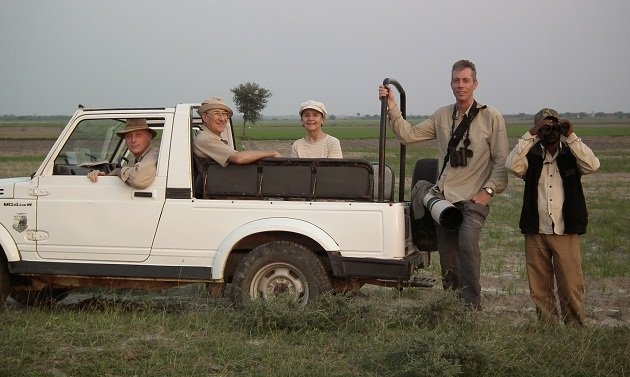 Thanks to BirdLife International, RSPB and Swarovski Optik as a BirdLife Species Champion for Sociable Lapwing, here you can find out more on the amazing migrations of birds fitted with satellite transmitters.
Thanks to BirdLife International, RSPB and Swarovski Optik as a BirdLife Species Champion for Sociable Lapwing, here you can find out more on the amazing migrations of birds fitted with satellite transmitters.
Find the other stages of the same tour here:
The carcass depository, Ahmedabad
Acknowledgements
For being invited to the Global Bird Watcher’s Conference, I would like to thank the organizers: Government of Gujarat, Gujarat Tourism Corporation and the Forest Department of Gujarat. The conference was organized by excellent J.N. Rao Travel, post-conference bird tour by Arpit Deomurari whose Indian list these days stand somewhere at 900+, so he is forced to chase endemics in the Himalayas and the Andaman Islands, and the lodge we used in Dasada was charming and lush green Rann Riders with the best cuisine we tried en route.
Sociable Lapwing photos by Chirag Solanki













Exciting stuff as always! I hope we can keep that one from going extinct.
On the size of SL population, BirdLife (http://www.birdlife.org/datazone/species/factsheet/22694053) says:
“Surveys in 2006 in Kazakhstan estimated 376 breeding pairs in an area of 145,000 km2. Extrapolating this population density across the breeding range yields a possible total population size of 5,600 breeding pairs, i.e. 11,200 mature individuals, roughly equivalent to 16,000-17,000 individuals in total; but work is continuing in order to refine this estimate. This total is consistent with record counts of 3,200 individuals in Turkey in October 2007.”